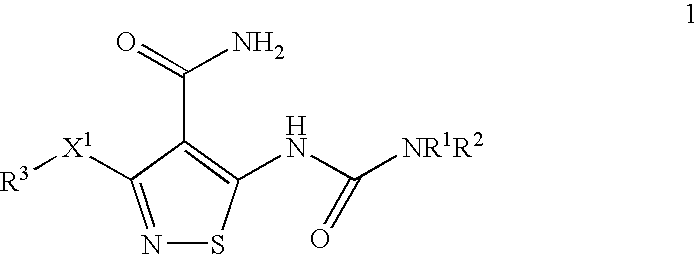Isothiazole Derivatives Useful as Anticancer Agents
a technology of isothiazole and derivatives, applied in the field of new drugs, can solve the problems of endothelial cell proliferation, tumor cell proliferation, etc., and achieve the effects of increasing in vivo half-life, facilitating preparation and delectability, and reducing the risk of cancer
- Summary
- Abstract
- Description
- Claims
- Application Information
AI Technical Summary
Benefits of technology
Problems solved by technology
Method used
Image
Examples
preparation 1
Dimethylcarbamoylisothiocyanate
[0138]A three liter, three-neck flask fitted with a mechanical stirrer was charged with dimethylcarbamyl chloride (250 mL, 2.70 mol) in anhydrous acetonitrile (1.5 L) and heated to reflux. Next was added potassium thiocyanate (270 g, 2.8 mol, pre-dried at 160° C. under high vacuum for 3 hours) portionwise over 1 hour with caution as the reaction bubbled violently at the start of each addition. After the final addition, the mixture was heated at reflux for an additional 1 hour. The heating mantle was removed and the mixture stirred at ambient temperature for an additional 2.5 hours and was then stored in the refrigerator overnight. The mixture was filtered to remove unwanted solid material and the filtrate concentrated. To the resulting oil was added ether (1 L) and the solid and thick material discarded. The filtrate was again concentrated affording the desired material a dull orange oil (204 g, 1.57 mol, 58%). 1H NMR (400 MHz, CDCl3) δ 2.90 (s, 3H), 2...
example 1
5-(3,3-Dimethyl-ureido)-3-hexylsulfanyl-isothiazole-4-carboxylic acid amide
[0143]A mixture of 3-(4-cyano-3-hexylsulfanyl-isothiazol-5-yl)-1,1-dimethyl-urea (0.09 g, 0.29 mmol) and concentrated sulfuric acid (0.18 mL) was stirred at ambient temperature for 1.5 hours. The mixture was diluted with ice water, extracted three times into ethyl acetate. The combined organic layers were dried over Na2SO4, filtered and concentrated in vacuo affording 0.076 g (78%) of 5-(3,3-dimethyl-ureido)-3-hexylsulfanyl-isothiazole-4-carboxylic acid amide as a colorless solid: 1H NMR (300 MHz, acetone-d6) δ 7.08 (bs, 2H), 3.20 (t. 2H, J=7.2 Hz), 3.02 (s, 6H), 1.63 (p, 2H, J=7.2 Hz), 1.35 (m, 2H), 1.23 (m, 4H), 0.78 (t, 3H, J=6.9 Hz) ppm; MS (APCI, m / z): 331 [M+H]+.
preparation 2
Sodium; 2,2-dicyano-1-ethoxycarbonylamino-ethenethiolate
[0144]Sodium metal (1.01 g, 44 mmol) was dissolved in 40 mL of ethanol at ambient temperature. The resulting solution was cooled in an ice bath, and malononitrile (2.91 g, 44 mmol) was added. The ice bath was removed, and the mixture was stirred at ambient temperature for 30 minutes. After cooling to 0° C., ethoxycarbonylisothiocyanate (5.77 g, 44 mmol) was added, and the mixture was allowed to warm to ambient temperature overnight. The mixture was concentrated in vacuo, and the residue solidified upon repeated dilution with hexane and concentration in vacuo. The resulting yellow solids were collected and dried in vacuo, affording 10.74 g (100%) or sodium, 2,2-dicyano-1-ethoxycarbonylamino-ethenethiolate as a light yellow solid that contained 0.5 molar equiv. of ethanol as indicated by 1H NMR spectroscopy. 1H NMR (300 MHz, DMSO-d6) δ 4.36 (t, 0.5H, J=5.0 Hz (EtOH)), 4.03 (q, 2H, J=7.1 Hz), 3.43 (dq, 1H J=5.0, 6.7 Hz (EtOH)), 1....
PUM
| Property | Measurement | Unit |
|---|---|---|
| temperature | aaaaa | aaaaa |
| temperature | aaaaa | aaaaa |
| temperature | aaaaa | aaaaa |
Abstract
Description
Claims
Application Information
 Login to View More
Login to View More - R&D
- Intellectual Property
- Life Sciences
- Materials
- Tech Scout
- Unparalleled Data Quality
- Higher Quality Content
- 60% Fewer Hallucinations
Browse by: Latest US Patents, China's latest patents, Technical Efficacy Thesaurus, Application Domain, Technology Topic, Popular Technical Reports.
© 2025 PatSnap. All rights reserved.Legal|Privacy policy|Modern Slavery Act Transparency Statement|Sitemap|About US| Contact US: help@patsnap.com



